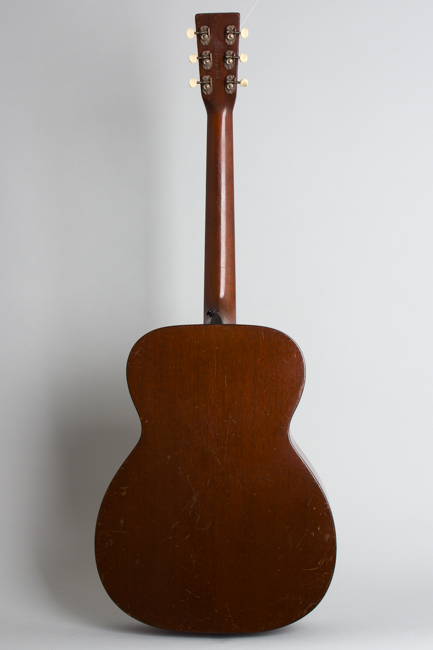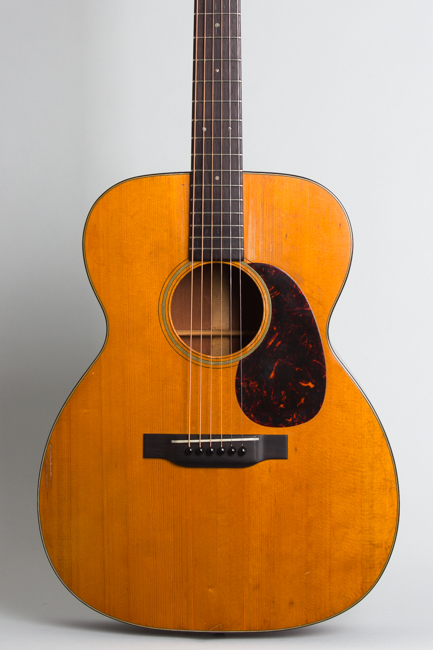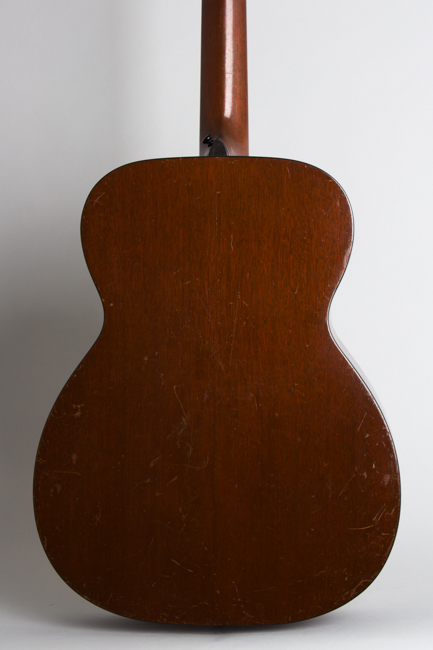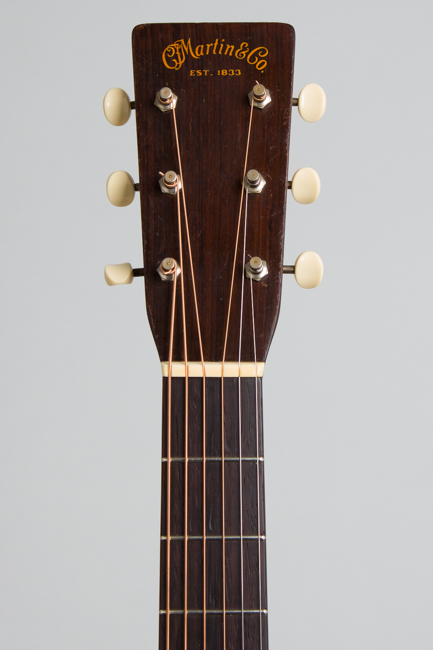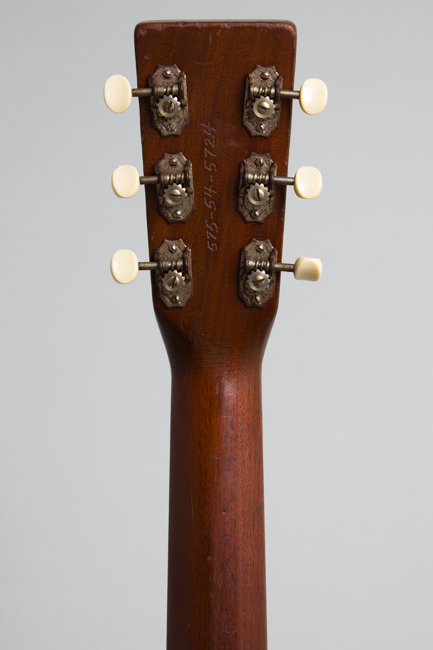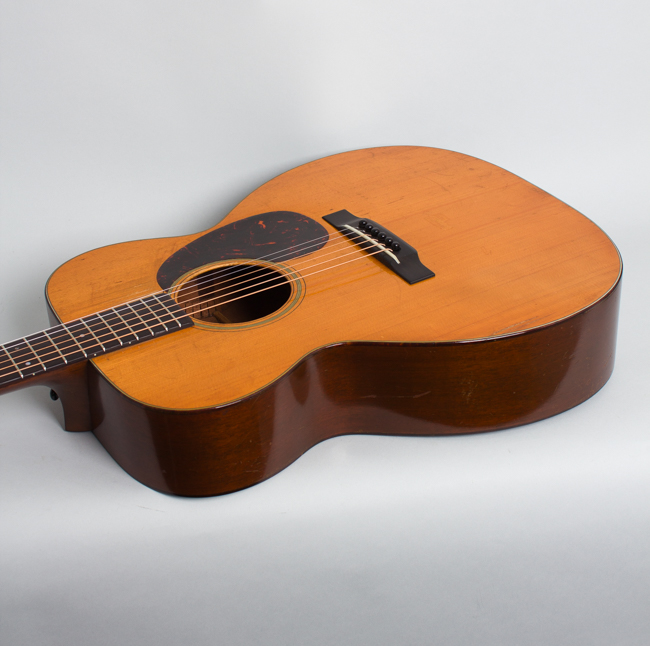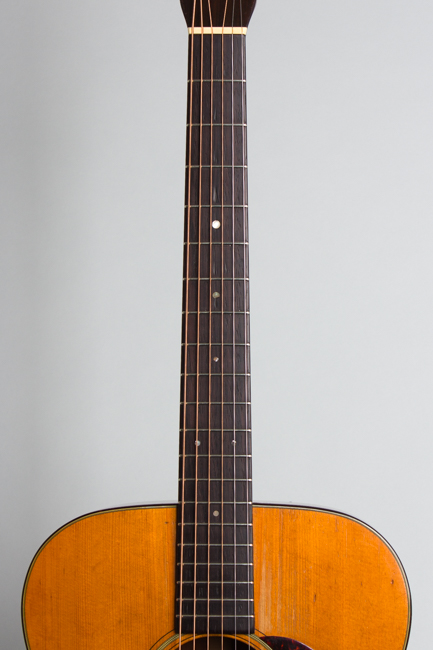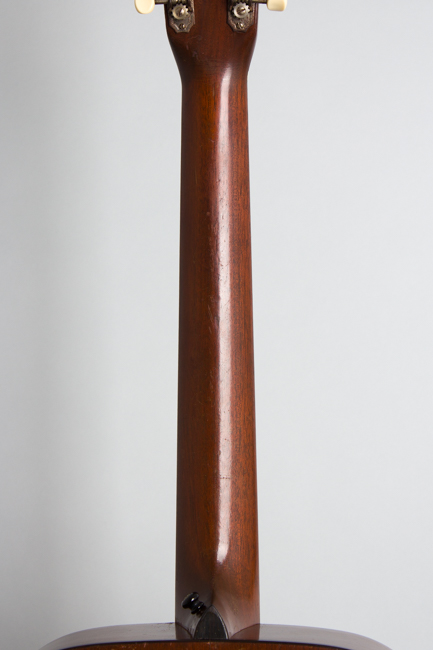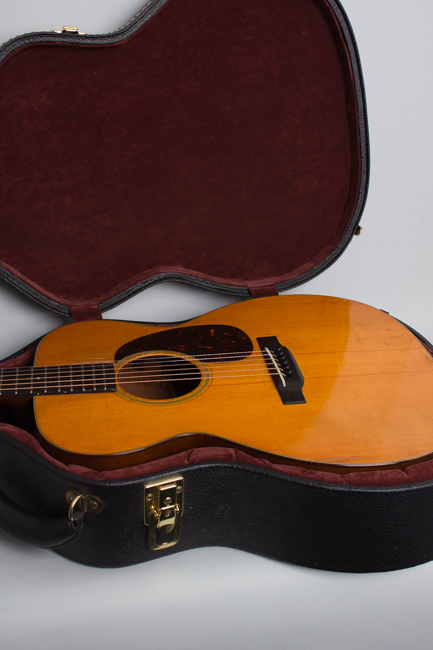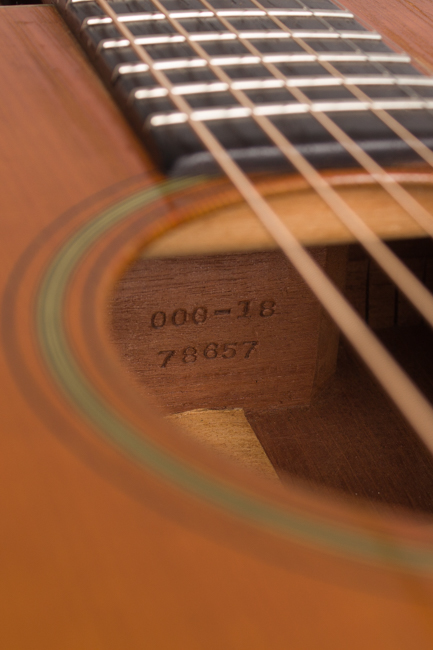C. F. Martin 000-18 Flat Top Acoustic Guitar (1941)
This item is currently on hold.
Item # 12460
Prices subject to change without notice.
C. F. Martin 000-18 Model Flat Top Acoustic Guitar (1941), made in Nazareth, PA, serial # 78651, natural lacquer finish, mahogany back and sides, spruce top, mahogany neck with ebony fingerboard, black hard shell case.
This (just) pre-war 000-18 may not be one of Martin's rarer creations, but to many players and Martin fans this model constitutes one of the company's most beloved combinations of wood, wire and inspiration. The very light mahogany body on this late pre-war example coupled with a delicately scallop-braced Adirondack spruce top makes for a very responsive guitar; the larger but narrow-waisted 000 size body contributes both depth and clarity to the sound.
This example was built in mid-1941, one of 326 000-18s shipped that year which was the model's largest annual total to date. While not particularly expensive by Martin standards in 1941 listing at $60.00 (plus case) the 000-18 still represented a substantial investment to many players at the time. Compared to some competitors in this price range (in 1941) his is not a flashy guitar; the trim is discreet with tortoise celluloid on the body edges and a simple multiply soundhole ring. In classic Martin style, the elegant understatement speaks for itself.
This particular guitar has a couple of distinctive features. The spruce top has a wider grain than many Martins from this era, visually enhanced by some long-grain "striping". Martin usually preferred plain tight-grain spruce; it is possible the conditions of the time (with Europe fully at war) was already affecting the supply of the Appalachian wood the company could select from. It has a rosewood fingerboard, which was a recently introduced appointment at this time replacing the more expensive (and harder to source) ebony on Style 18 models.
Despite its lack of flash this was always a fully professional instrument popular with radio entertainers, most obviously the country acts common in the southeast. In the years since WWII, Martins of this era have become the benchmark for all subsequent acoustic guitar designs. This scallop-braced 000-18 is an extremely versatile instrument; it can be used to play effectively in virtually any style of music. Both as a creative tool and as an object of beauty and grace, this is a distinctive and wonderful example of Martin's contribution to the art of the American guitar.
Overall length is 40 in. (101.6 cm.), 15 1/8 in. (38.4 cm.) width, and 4 1/8 in. (10.5 cm.) in depth at side, taken at the end block. Scale length is 24 3/4 in. (629 mm.). Width of nut is 1 11/16 in. (43 mm.).
This is a fine playing specimen of a late pre-WWII 000-18 showing some fairly extensive general finish wear but only typical maintenance repair. There are noticeable scratches, dings and dents to the all-original finish overall, most heavily to the back, lower side and lower treble side area of the top. There is fairly heavy pickwear to the wood on either side of the fingerboard, particularly just below off the front tip of the pickguard. The back of the neck is worn down to the wood over a decent amount of its length but has none of the often seen deep capo marks, only a few small dinks and dents. An old Social Security or driver's license number is etched into the back of the peghead, and there is a spot on the top below the bridge where an old sticker left an impression in the finish. .
There are a couple of short tightly sealed grain cracks on the treble side rim, one of which looks to have been covered by a piece of tape (now removed) for decades. There are a few deep scratches to the upper edge of the top but no other crack repairs are detectable. The neck has been reset more than once. The latest job is by Willi Henkes in Germany; his work is impeccable and the angle is excellent. There are a couple of small chips to the sides of the heel from an earlier neckset, neatly patched in but visible. The ebony bridge is a beautiful correct replacement also by Willi. Internally the lovely scalloped bracing and the original small maple bridgeplate are intact and unaltered, with a few small errant glue spots. The original openback Kluson tuners are intact, with some worn plating but still working well.
Willi Henkes also executed a perfect refret with the fingerboard trued, and this is a truly superb playing guitar. The sound is both precise and expansive, with an unmatched combination of transparent clarity and depth. This mahogany 000 excels as both a finger- or flatpicked instrument, and is perfectly suited to a wide range of musical applications. This is played-in but structurally excellent example not "to clean to play" but ready to go in a later HSC Overall Very Good + Condition.
This (just) pre-war 000-18 may not be one of Martin's rarer creations, but to many players and Martin fans this model constitutes one of the company's most beloved combinations of wood, wire and inspiration. The very light mahogany body on this late pre-war example coupled with a delicately scallop-braced Adirondack spruce top makes for a very responsive guitar; the larger but narrow-waisted 000 size body contributes both depth and clarity to the sound.
This example was built in mid-1941, one of 326 000-18s shipped that year which was the model's largest annual total to date. While not particularly expensive by Martin standards in 1941 listing at $60.00 (plus case) the 000-18 still represented a substantial investment to many players at the time. Compared to some competitors in this price range (in 1941) his is not a flashy guitar; the trim is discreet with tortoise celluloid on the body edges and a simple multiply soundhole ring. In classic Martin style, the elegant understatement speaks for itself.
This particular guitar has a couple of distinctive features. The spruce top has a wider grain than many Martins from this era, visually enhanced by some long-grain "striping". Martin usually preferred plain tight-grain spruce; it is possible the conditions of the time (with Europe fully at war) was already affecting the supply of the Appalachian wood the company could select from. It has a rosewood fingerboard, which was a recently introduced appointment at this time replacing the more expensive (and harder to source) ebony on Style 18 models.
Despite its lack of flash this was always a fully professional instrument popular with radio entertainers, most obviously the country acts common in the southeast. In the years since WWII, Martins of this era have become the benchmark for all subsequent acoustic guitar designs. This scallop-braced 000-18 is an extremely versatile instrument; it can be used to play effectively in virtually any style of music. Both as a creative tool and as an object of beauty and grace, this is a distinctive and wonderful example of Martin's contribution to the art of the American guitar.
Overall length is 40 in. (101.6 cm.), 15 1/8 in. (38.4 cm.) width, and 4 1/8 in. (10.5 cm.) in depth at side, taken at the end block. Scale length is 24 3/4 in. (629 mm.). Width of nut is 1 11/16 in. (43 mm.).
This is a fine playing specimen of a late pre-WWII 000-18 showing some fairly extensive general finish wear but only typical maintenance repair. There are noticeable scratches, dings and dents to the all-original finish overall, most heavily to the back, lower side and lower treble side area of the top. There is fairly heavy pickwear to the wood on either side of the fingerboard, particularly just below off the front tip of the pickguard. The back of the neck is worn down to the wood over a decent amount of its length but has none of the often seen deep capo marks, only a few small dinks and dents. An old Social Security or driver's license number is etched into the back of the peghead, and there is a spot on the top below the bridge where an old sticker left an impression in the finish. .
There are a couple of short tightly sealed grain cracks on the treble side rim, one of which looks to have been covered by a piece of tape (now removed) for decades. There are a few deep scratches to the upper edge of the top but no other crack repairs are detectable. The neck has been reset more than once. The latest job is by Willi Henkes in Germany; his work is impeccable and the angle is excellent. There are a couple of small chips to the sides of the heel from an earlier neckset, neatly patched in but visible. The ebony bridge is a beautiful correct replacement also by Willi. Internally the lovely scalloped bracing and the original small maple bridgeplate are intact and unaltered, with a few small errant glue spots. The original openback Kluson tuners are intact, with some worn plating but still working well.
Willi Henkes also executed a perfect refret with the fingerboard trued, and this is a truly superb playing guitar. The sound is both precise and expansive, with an unmatched combination of transparent clarity and depth. This mahogany 000 excels as both a finger- or flatpicked instrument, and is perfectly suited to a wide range of musical applications. This is played-in but structurally excellent example not "to clean to play" but ready to go in a later HSC Overall Very Good + Condition.


